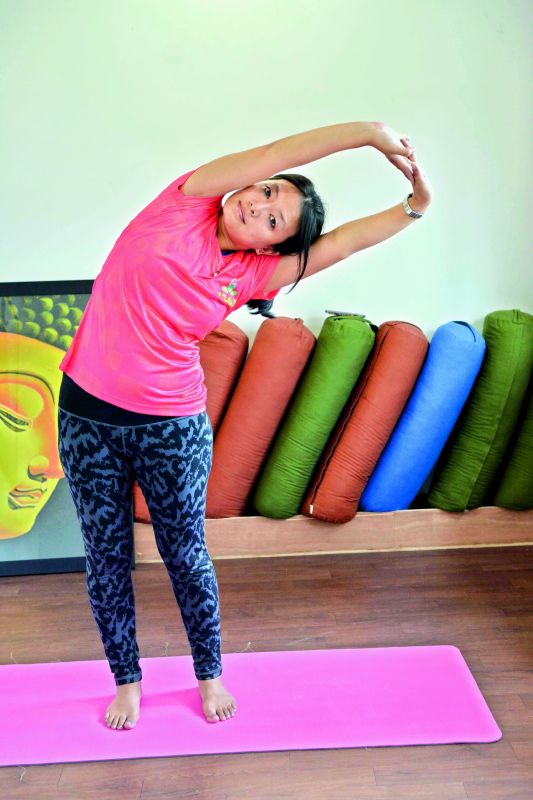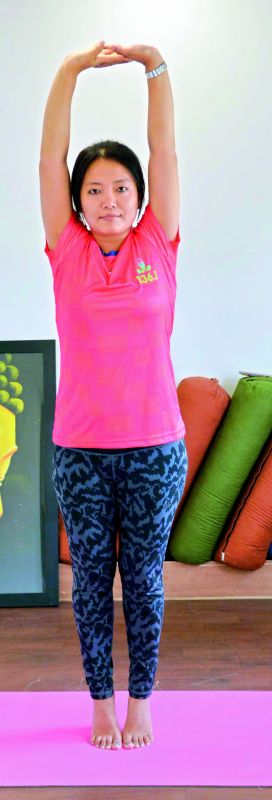Yogini's guide to dexterity
Ladies, practise these simple asanas and reap the benefits.

The benefits of yoga for women are manifold. Though there are many asanas, sometimes they skip the most important ones due to various reasons. Here are six different yoga asanas that can be practiced on a daily basis and the benefits are immense. It is better to practice these under an experienced yoga teacher. Self practice is not encouraged.
Paschimottasana
Starting position: Sit on the floor with the legs outstretched, feet together and hands on the knees.
Moving: Take a deep breath in and slowly while exhaling, bend from the hips sliding the hands down the legs and try reaching the big toes with fingers and thumbs. Keep your back and legs relaxed. Try to touch the forehead with the knees otherwise look at the knees. During the final position, keep breathing. As you come out inhale, and come up.
Rounds: Three rounds

Benefits: Stretches the hamstrings and increases flexibility in hip joints. Tones and massages the entire abdominal and pelvic region including liver, pancreas, spleen, kidneys and adrenal glands. Removes excess weight in this area and helps alleviate disorders of the uro-genital system. Nerves and muscles of the spine get toned. The asana is used in the management of prolapse, menstrual disorders, sluggish liver, diabetes, colitis, kidney complaints and bronchitis and eosinophilia.
Contra: Those who suffer from slipped disc or sciatica or lower back pain.
Triyaka Tadasan
Starting position: Stand with feet 2 feet apart and the weight distributed equally on both legs. Interlock the fingers in front with the palms turned outwards. Fix your eyes at any point in the front.
Moving: Inhale and raise the arms over your head, palms facing upward. Exhaling, side bend to the left side first from the waist. While inhaling, come to the centre and exhaling, go to the right side.

Rounds: Right and left will make one round. Everyday practice for 5 to 10 rounds.
Benefits : Loosens and exercises the sides of the waist.
Marjari Asana
Starting position: Sit in Vajrasana
Moving: Raise the buttocks and stand on the knees. Lean forward, place palms on the floor with the fingers pointing forward. Knees can be together or slightly separated. Hands should be in line with the knees. Inhaling, slowly raise the head and depressing the spine so that the back becomes concave. Exhaling, lower the head and stretch spine upward and contract abdomen.
Rounds: 8 to 10 rounds.
Benefits: The asana improves the flexibility of the neck, shoulders and spine. It also tones female reproductive system. Women having menstrual disorder will benefit from the practice.
Ardha matsyendra asana
Starting position: Sit with the legs stretched out in front of the body.
Moving: Bend the right leg and place the right foot flat on the floor on the outside of the left knee. Toes should face forward. Bend the left leg and bring the foot around to the right buttock. Extend your left arm through the space between the chest and the right knee, and place it against the outside of the right leg. Raise the right arm and slowly twist to the right, simultaneously move the arm trunk and head and look over the right shoulder. The right arm can be wrapped around the back of the waist or can be kept on the floor. Hold the position for a minute or so and keep breathing while holding. As you return to original position, inhale and return.
Rounds: One round.
Benefits: Stretches the muscles on one side of the back and abdomen. Tones the nerves of the spine, makes the back muscles supple, and relieves lumbago and muscular spasms. Alleviates digestive ailments and helps in secretion of adrenaline and bile. Helps in the yogic management of diabetes, bronchitis, constipation, colitis, menstrual disorders, urinary tract disorders, and cervical spondylitis.
Contra: Pregnant women, people suffering from peptic ulcer, hernia, and hyperthyroidism.
Tadasana
Starting position: Place your feet together or 10 cm apart with the arms beside the body. The weight should be distributed equally on both legs. Interlock the fingers in the front and raise your arms up with the palms facing upwards. Place the hands on the top of the head and fix your eyes at any point in the front.

Moving: While inhaling, stretch your arms up, shoulders and chest should be upward. Heels will be off the floor. Stretch your whole body. Hold the breath for a count of five and then while exhaling, lower the heels and palms over the floor.
Rounds: Practice 10 rounds daily.
Benefits: Develops physical and mental balance. Stretches the spine and helps in clearing congestion of the spinal nerves. Keeps the abdominal muscles and nerves toned.
Kandharasana asana
Starting position: Lie flat on the back. Bend the knees, placing the soles of the feet flat on the floor with the heels touching the buttocks. The feet and the knees may be hip-width apart. Grasp the ankles with the hands.
Moving: Raise the buttocks and arch the back upward. Raise your chest and navel as high as you can pushing the chest up towards chin and head without moving the position of the feet and shoulders. The feet should remain flat on the floor. Hold the posture as long as you can, then exhaling, lower the buttocks.
Inhale deeply in the starting position and retain the breath inside while raising and holding. Exhale while coming down.
Rounds: Five rounds
Benefits: Re-aligns the spine, eliminating rounded shoulders, relieving backache, is a good massage to the colon and improves digestion. Tones female reproductive system, good practice for the management of menstrual disorders, prolapse, asthma and various bronchial and thyroid conditions.
Contra: If suffering from peptic or duodenal ulcers. Advance stages of pregnancy.
(The writer is a Chennai-based yoga expert. The exercises have been performed by Tshering, a yoga instructor.)
